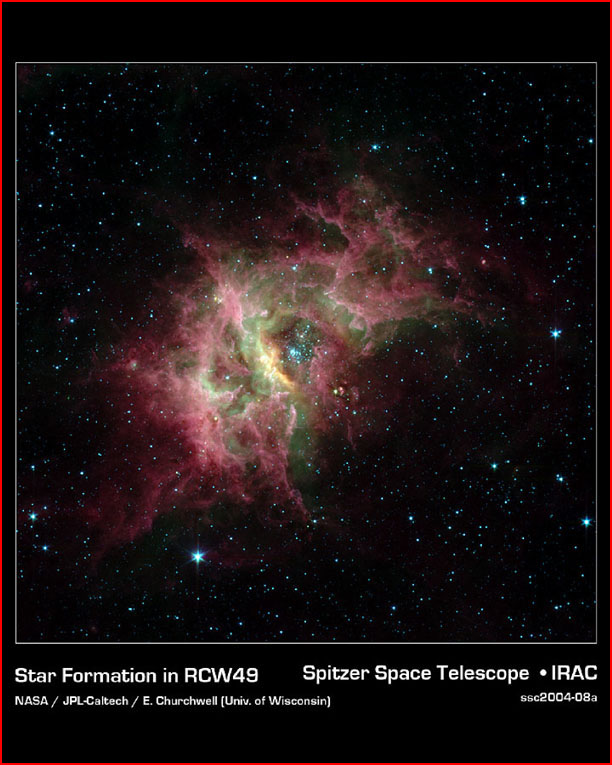|
|
||
 Credit: NASA/JPL-Caltech/E. Churchwell (University of Wisconsin) |
||
|
pic of the day Links:
Society for
|
Jul 27, 2004 New, high resolution images challenge the traditional “nebular theory” of star and planet formation, revealing turbulent plasma and magnetic fields, the markers of electric currents. The nebular theory of star and planet formation from a cloud of gas and dust that collapses under its own gravity was proposed in the 18th century by Kant and Laplace. It was modified in the 19th century and again in the 20th century to accommodate objections. Because gravity is a very weak force, to collapse under its own weight the cloud needs to be cool and free from magnetic fields which might disturb the process. But in the stellar nurseries that have been identified, the new stars are embedded in turbulent regions of hot dust, glowing plasma and magnetic fields. A quick tweak of the theory is all that was needed to adjust it to this requirement: The abundant shockwaves from stellar winds and supernovas in star-forming regions can then trigger the gravitational collapse that begins the star-and-planet forming process. But this ignores other problems. The origin of stellar "winds" remains a mystery. And shock-heated gases should quickly disperse, not collapse. Nevertheless, these newborn stars are surrounded by what appears to be the disks from which the nebular theory expects planets to be born. This observation is encouraging theorists to look for mechanisms to dissipate the heat and magnetism during the collapse phase. The Electric Universe sees a contrary picture. The turbulent plasma and magnetic fields are side effects of the formation of electric stars. How does this work? The Birkeland currents that power and define the shape of the galaxy are constricted by the magnetic fields they generate. The hot gas and dust cannot disperse. When the current density gets high enough, the plasma that carries the current begins to glow and to pinch off into stars. The form this takes is a sphere with polar plumes surrounded by a toroid (donut shape). This has been reproduced in laboratory experiments. When the electrical stress is low and the plasma less dusty, as it is for our single star, only the star "lights up." Where the stress is greater, as in stellar nurseries, equatorial "disks" (toroids), polar "jets" (plumes), and the surrounding gas and dusty plasma can also be "lit up". [Cold dust clouds can also shine by the reflection of starlight or can be silhouetted in front of brighter clouds.] The glowing cosmic plasma formations show the characteristic filaments, arcs, spirals and cell formations seen in plasma labs and in computer simulations of plasma behavior. |
|
|
Copyright 2004: thunderbolts.info |
||
